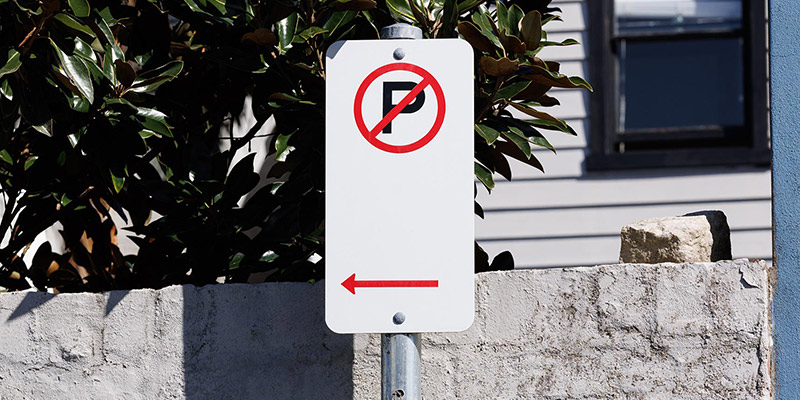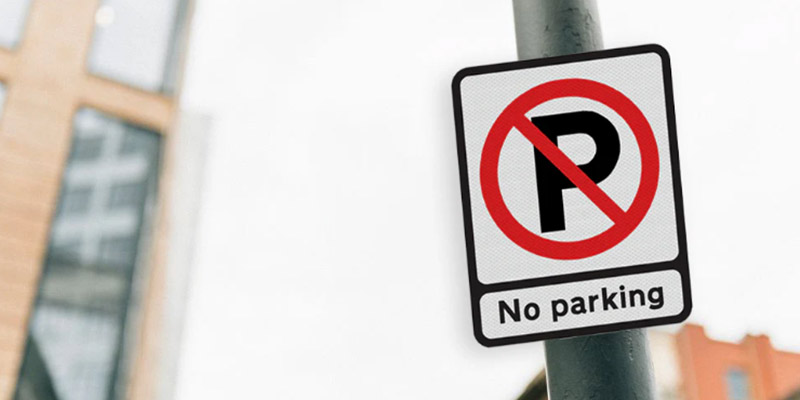In city streets, school entrances, and beside hospital emergency lanes, you'll always spot those red-and-white signs—no parking zones. Simple in appearance, they clearly mark the boundary between where you can park and where you cannot.
Yet many drivers constantly push the limits: interpreting “no prolonged parking” as “temporary stops are fine,” or treating “no parking” signs near fire lanes as “ignorable decorations.” Little do they realize that each act of disregard can cause traffic jams, delay rescues, and ultimately result in hefty fines. Today, we’ll thoroughly decipher no-parking signs and understand why high-quality signage is essential for road safety.
According to the national standard “Road Traffic Signs and Markings,” no parking signs fall under “prohibition signs.” Their core appearance is “circular with a red background and white border,” with specific no-parking rules distinguished by the internal symbols.
High-quality no-parking signs utilize highly reflective film material, ensuring clear visibility from 50 meters away even in adverse conditions like heavy rain or darkness. This is fundamental to the sign's “effective communication”—if the sign is unclear, even the strictest rules become unenforceable.
Many confuse “No Parking” with “No Long-Term Parking,” despite their distinct symbols and rules—and the consequences of misjudgment vary dramatically.
Simply put:
- A red circle with a red cross signifies “Absolute No Parking.” This prohibits both temporary passenger drop-offs/pick-ups and extended stops. A red circle with a diagonal red line indicates “No Long-Term Parking,” permitting temporary stops for passenger pickup/drop-off or loading/unloading, but the driver must remain in the vehicle, typically not exceeding 3 minutes.

The placement of no-parking signs is scientifically determined, each location tied to “lifelines” and “traffic efficiency.” The risks of unauthorized parking extend far beyond fines.
Fire lanes serve as “lifelines” for fire rescue operations. Regulations mandate a minimum width of 4 meters, with strict prohibition against any vehicle stopping. Hospital emergency access routes function as “green channels” for critically ill patients—even a second of congestion can delay vital treatment.
No-parking signs in these zones typically feature the text “Fire Lane - No Occupancy.” Violations incur a 200 yuan fine, 6 demerit points, and mandatory vehicle towing. If obstruction hinders rescue efforts, legal liability may apply.
During school drop-off and pick-up times, dense student traffic requires no-parking signs within 30 meters of school entrances to prevent vehicles from obstructing visibility and causing collisions with students. Similarly, no-parking zones within 50 meters of intersections and 30 meters of bus stops ensure smooth turning maneuvers and bus operations, reducing congestion and accidents.
At one elementary school entrance, a temporary stop by a vehicle caused a student crossing the road to be struck by a right-turning car. Subsequently, high-visibility no-parking signs were added to the area, enforcement was strengthened, and similar hazards were completely eliminated.
Tunnels and bridges have enclosed spaces where parked vehicles can cause rear-end collisions. No-parking signs in construction zones protect workers and ensure project progress. These zones typically feature absolute “red cross” no-parking signs, with stricter penalties for violations—some cities impose a direct 12-point deduction.
While driving, proactively scan roadside signage. Upon spotting a “red circle with red cross/diagonal line” sign, immediately plan your parking route. Avoid complacency with thoughts like “it's just a quick stop.” Especially on unfamiliar roads, use navigation apps to locate nearby parking facilities in advance.
If encountering a “red circle with diagonal red line” sign prohibiting long-term parking, ensure that when temporary stopping is necessary, you “stay with your vehicle and move quickly.” After picking up/dropping off passengers or loading/unloading items, depart immediately to avoid exceeding the permitted time.
In urgent situations (e.g., sudden illness of passengers), temporary stops in no-parking zones are permitted. Immediately call 110 to explain the circumstances, activate hazard lights, and place warning signs. Submit relevant documentation afterward to request penalty dismissal.
For municipal departments, property management, schools, and other procurement entities, high-quality no-parking signs are “essential for enforcing regulations.” Substandard signs offer poor reflectivity, fade easily, and have weak wind resistance—failing to warn drivers and potentially causing disputes due to illegibility. Our no-parking signs are engineered for effective warning from material to craftsmanship:
Features Class IV ultra-reflective film compliant with national standards, achieving ≥200 cd/m² reflectivity under vehicle headlights at night and clear visibility from 50 meters away. Surface coated with UV-resistant layer maintains color integrity after 5 years of sun exposure and retains appearance during heavy rain or snow.
Sign panels utilize 1.2mm thick aluminum alloy sheets with wind load resistance up to Category 12, withstanding typhoons and torrential rains. Impact-resistant rubber bumpers on frames prevent injuries from pedestrian or vehicle collisions while extending service life.
Dimensions (60cm-120cm) and text prompts (e.g., “Fire Lane - No Occupancy,” “School Zone - No Parking”) can be tailored to installation environments. Includes matching poles and mounting hardware with on-site installation and calibration to ensure proper signage placement and operational efficiency.

A small no parking sign connects drivers' habits, pedestrians' safety, and the entire city's traffic order. Understanding its rules is every road user's responsibility; selecting quality signs is every purchaser's duty.
If you are procuring no-parking signs for municipal roads, schools, communities, hospitals, or similar settings, we welcome your inquiry. Grounded in national standards and backed by professional service, we ensure every sign is “clear, conspicuous, durable, and reliable.” This commitment helps enforce no-parking regulations effectively, making every road safer and more orderly.